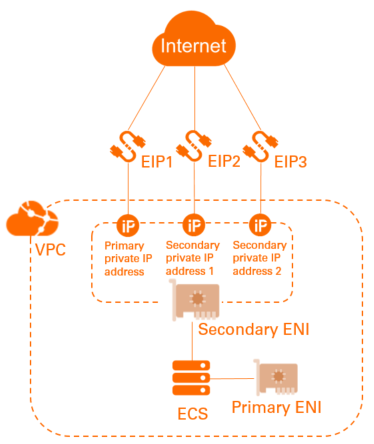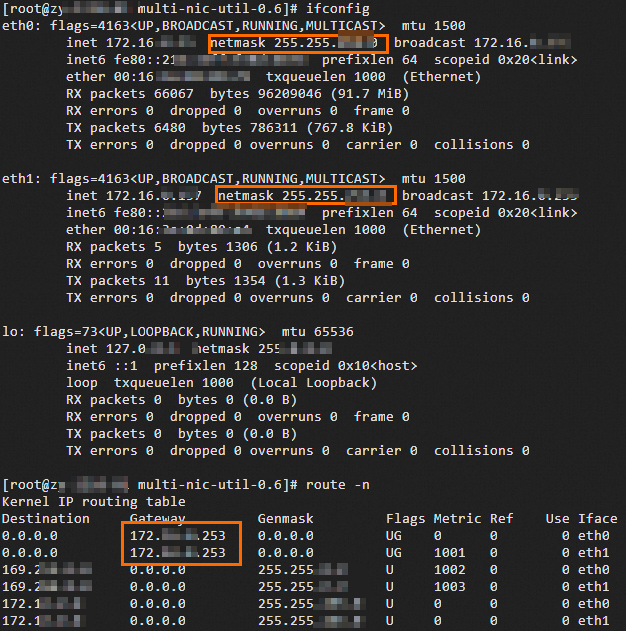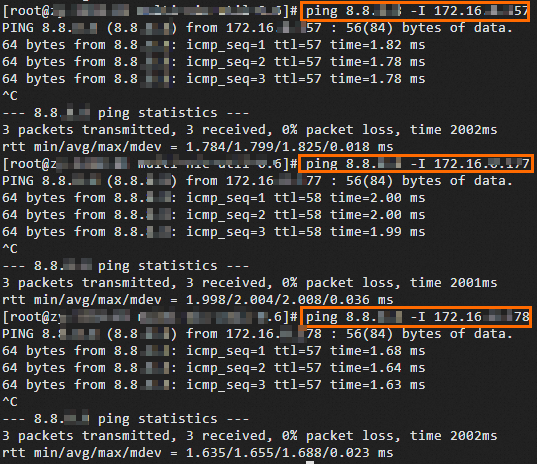If you want to deploy multiple applications on an Elastic Compute Service (ECS) instance and each application uses a unique public IP address, you can associate multiple elastic IP addresses (EIPs) with a secondary elastic network interface (ENI) in NAT mode. Then, associate the secondary ENI with the ECS instance. This way, the EIPs are associated with the ECS instance.
Background information
You can assign multiple secondary private IP addresses to a secondary ENI.
The number of private IP addresses that can be assigned to a secondary ENI is determined by the status of the secondary ENI and the specification of the ECS instance associated with the secondary ENI. For more information, see Assign secondary private IP addresses.
Each secondary private IP address can be associated with an EIP in NAT mode.
For more information, see Associate an EIP with a secondary ENI.
An ECS instance can communicate with the Internet if the ECS instance is assigned a public IP address. If you do not use a secondary ENI, each ECS instance can be assigned only one static public IP address or associated with only one EIP.
To assign multiple public IP addresses to an ECS instance, you can associate EIPs with a secondary ENI, and then associate the secondary ENI with the ECS instance. If the ECS instance hosts multiple applications, each application uses a unique public IP address to communicate with the Internet. This improves the utilization of the ECS instance.
Scenarios
The following scenario is used in this topic. A company created an ECS instance on Alibaba Cloud to deploy websites and associated an EIP with the ECS instance.
To meet business requirements, the company needs to deploy three sub-websites on the ECS instance and each sub-website uses a unique EIP to provide services.
You can assign one primary private IP address and two secondary private IP addresses to a secondary ENI. Then, associate multiple EIPs with the private IP addresses in NAT mode. This way, the ECS instance is associated with multiple EIPs.
Prerequisites
Before you start, make sure that the following requirements are met:
Resource | Requirement | References |
Elastic Compute Service (ECS) instance |
| |
Secondary ENI |
| |
EIP | The EIPs to be associated and the secondary ENI must belong to the same region. |
When you use the quick deployment method, you can create a new instance or use an existing instance.
If you create a new instance, you do not need to create the preceding resources.
If you use an existing instance, you must first create the preceding instances and the ECS instance must run CentOS 7.x.
Procedure
Manual deployment
Procedure

In this topic, the new ECS console is used as an example. You can click the button in the lower-left part of the navigation pane to switch between the new version and the previous version.
Operations in this topic involve restarting the network service and configuring routes. We recommend that you perform the operations during off-peak hours to avoid service interruptions.
Step 1: Associate the secondary ENI with the ECS instance
Log on to the ECS console.
In the left-side navigation pane, choose .
In the top navigation bar, select the region and resource group to which the resource belongs.

Find the secondary ENI and click Bind to Instance in the Actions column.
In the Bind to Instance dialog box, select an ECS instance and click OK.
Refresh the list. If InUse is displayed in the Status column, the secondary ENI is associated with the ECS instance.
If you cannot associate the secondary ENI with the ECS instance, possible causes are:
The number of secondary ENIs associated with the ECS instance has reached the upper limit. For more information, see Instance families. For more information about how to upgrade instance specifications, see Overview of instance configuration changes.
The ECS instance can be associated with a secondary ENI only if the ECS instance is in the Stopped state. For more information, see Prerequisites.
Step 2: Assign multiple secondary private IP addresses to the secondary ENI
You can assign multiple secondary private IP addresses to the secondary ENI and associate the secondary ENI with the ECS instance. This ensures high utilization and service availability of the ECS instance.
Log on to the ECS console.
In the left-side navigation pane, choose .
In the top navigation bar, select the region and resource group to which the resource belongs.

On the ENIs page, find the ENI and click Manage Secondary Private IP Address in the Actions column.
In the Manage Secondary Private IP Address dialog box, click Assign New IP in the IPv4 Addresses section, assign an IP address as needed, and then click OK.
Assign New IP is clicked twice in this example. This way, two secondary private IP addresses are automatically assigned to the secondary ENI.
NoteYou can also enter a secondary private IP address that falls within the private IPv4 CIDR clock. If you do not enter a secondary private IP address, the system assigns an idle IP address from the private IPv4 CIDR block.

You can view the assigned secondary private IP address in the Private IP Address column of the secondary ENI.
Step 3 (optional): Configure the ENI on the ECS instance
After you associate the secondary ENI with the ECS instance, some images may fail to identify the IP address of the ENI or add routes. As a result, the secondary ENI cannot work as expected. In this case, you need to configure the secondary ENI on the ECS instance so that the IP address of the ENI can be identified.
For more information about how to check whether an ECS instance image supports the associated secondary ENI and how to configure an secondary ENI on an ECS instance, see Configure a secondary ENI.
Step 4: Configure a secondary private IP address for the ECS instance
After you associate the secondary ENI with the ECS instance, you need to configure a secondary private IP address for the ECS instance.
An ECS instance that runs Alibaba Cloud Linux 2 is used in this example to describe how to configure a secondary private IP address for an ECS instance. For more information about the procedure for ECS instances that run other operating systems, see Assign secondary private IP addresses.
Connect to an ECS instance.
For information about the connection methods, see Connection method overview.
Run the
ifconfigcommand to query the subnet mask and run theroute -ncommand to query the default gateway.The following figure shows an example output.

255.255.**.**corresponding to netmask is the IPv4 subnet mask, and172.**.**.253corresponding to Gateway is the default gateway.Modify the network configuration file.
Run the
vi /etc/sysconfig/network-scripts/ifcfg-eth1:0command to add configurations.Example:
DEVICE=eth1:0 TYPE=Ethernet BOOTPROTO=static ONBOOT=yes IPADDR=<Assigned secondary private IPv4 address 1> NETMASK=<IPv4 subnet mask>Run the
vi /etc/sysconfig/network-scripts/ifcfg-eth1:1command to add configurations.Example:
DEVICE=eth1:1 TYPE=Ethernet BOOTPROTO=static ONBOOT=yes IPADDR=<Assigned secondary private IPv4 address 2> NETMASK=<IPv4 subnet mask>
Run the following command to restart the network service so that the configuration can take effect.
service network restartRun the
ifconfigcommand to view the configuration result.The following figure shows the output of the command used to configure two secondary private IP addresses.

Step 5: Associate the EIP with the secondary private IP address
- Log on to the Elastic IP Address console .
On the Elastic IP Addresses page, find the EIP that you created and click Associate with Resource in the Actions column.
In the Associate EIP with Resource dialog box, set the following parameters and click OK.
Instance Type: Select Secondary ENI.
ImportantSelect Secondary ENI. If you select ECS Instance, you cannot associate the EIP with the secondary private IP address.
Resource Group: Select the resource group to which the secondary ENI belongs.
Mode: Select NAT Mode.
Select an instance to associate: Select the secondary private IP address. You can view the secondary private IP address in the Private IP Address column of the secondary ENI.
In this example, the primary private IP address of the secondary ENI is selected.
Repeat the preceding steps to associate the other two EIPs with the secondary private IP addresses of the secondary ENI.
Step 6: Configure routes
An ECS instance that runs Alibaba Cloud Linux 2 is used in this example to describe how to configure routes for an ECS instance. For more information about the procedure for ECS instances that run other operating systems, see Step 4 (optional): Configure routes.
Configure routes for the secondary ENI on the ECS instance
Connect to an ECS instance.
For information about the connection methods, see Connection method overview.
Run the following command to query route information.
route -nThe following route information about the primary ENI (eth0) and the secondary ENI (eth1) is returned.

Run the following command to configure default routes.
ip -4 route add default via 172.16.**.253 dev eth1 metric 1001 && \ ip -4 route add default via 172.16.**.253 dev eth1 table 1001 && \ ip -4 rule add from 172.16.**.*57 lookup 1001 && \ ip -4 rule add from 172.16.**.*77 lookup 1001 && \ ip -4 rule add from 172.16.**.*78 lookup 1001NoteThe preceding command adds default routes to eth1, creates a route table, and associates three routing policies associated with the route table.
table 1001is the route table (consistent with the metric value of the default route).172.16.**.253is the IP address of the gateway.172.16.*.*57is the primary private IP address of eth1.172.16.**.*77and172.16.**.*78are two secondary private IP addresses of eth1. Specify the parameters based on actual information.Run the following command to view the created route table and routing policies.
ip route list table 1001 && \ ip rule listIf the following output is returned, the route table and routing policies are created.

Optional: If the existing routes do not meet your requirements, you can configure route tables and rules.
You can configure route tables and rules to implement routing policies, which allow you to forward traffic through specified gateways. This allows you to control and manage network traffic in a more fine-grained way.
Configure automatic route update on instance startup
After you configure routes for the secondary ENI, you need to configure automatic route update on instance startup. Otherwise, the routes become invalid.
Run the following command to open the
/etc/rc.localfile.vim /etc/rc.localPress the
Ikey to enter the edit mode, add the following content, press theEsckey to exit the edit mode, and then enter:wqto save and exit.ip -4 route add default via 172.16.**.253 dev eth1 metric 1001 ip -4 route add default via 172.16.**.253 dev eth1 table 1001 ip -4 rule add from 172.16.**.*57 lookup 1001 ip -4 rule add from 172.16.**.*77 lookup 1001 ip -4 rule add from 172.16.**.*78 lookup 1001Run the following command to grant execute permissions on the
/etc/rc.localfile.sudo chmod +x /etc/rc.local
Step 7: Test the network connectivity
An ECS instance that runs Alibaba Cloud Linux 2 is used in this example to describe how to test the connectivity between the ECS instance and the destination network.
Log on to the ECS instance.
For information about the connection methods, see Connection method overview.
Run the following command to check the connectivity between the secondary private IP address and the destination network:
ping <Destination network> -I <Secondary private IP address>The result shows that the secondary private IP addresses can access the destination network, which indicates that the secondary private IP addresses are associated with the EIPs.

Quick deployment
You can use Resource Orchestration Service (ROS) to implement quick deployment, which allows you to quickly associate multiple EIPs with an ECS instance.
The quick deployment feature allows you to associate three EIPs with an ECS instance. If you need a more flexible configuration solution, we recommend that you select Manual Deployment.
Click the Template to go to the Resource Orchestration Service (ROS) console.
In the top navigation bar, select the region of the EIP.
On the Configure Template Parameters wizard page, enter a stack name, select Use Existing ECS/EIP/ENI or Create ECS/EIP/ENI, set the following parameters, and then click Create.
Select Use Existing ECS/EIP/ENI: Select an ECS instance, and enter a secondary ENI ID and three EIP IDs.
If you select Create ECS/EIP/ENI, you need to select a zone, instance type, and system disk type, and enter a password.
ImportantIf you select Create ECS/EIP/ENI, the system automatically creates a pay-as-you-go ECS instance that runs CentOS 7.x and three pay-as-you-go EIPs. For more information about the billing methods of ECS instances and EIPs, see ECS billing overview and EIP billing overview.
If Creating changes to Created in the Status section on the Stack Information tab, the resources are deployed.
Log on to the ECS instance.
For information about the connection methods, see Connection method overview.
Run the following command to check the connectivity between the secondary private IP address and the destination network:
ping <destination network> -I <secondary private IP address>The result shows that the secondary private IP addresses can access the destination network, which indicates that the secondary private IP addresses are associated with the EIPs.

FAQ
Am I charged an EIP configuration fee after I associate an EIP with a secondary ENI?
You are not charged an EIP configuration fee for subscription EIPs.
You are charged an EIP configuration fee (public IP retention fee) if you associate a pay-as-you-go EIP with a secondary ENI.
Do I need to perform additional configurations after I associate an EIP with an ENI and associate the ENI with an ECS instance?
If applications that provide services, such as websites, are deployed on the ECS instance, you do not need to configure routes on the ECS instance or in the VPC. The EIP associated with the secondary ENI can be used to provide services.
If you want the ECS instance to access the Internet, you must configure the default route of the ECS instance or create specific routes for the ECS instance. By default the primary ENI is used to forward packets to the Internet. You can adjust route priorities to use the secondary ENI to forward packets. You can also create specific routes to forward packets to the Internet from multiple ENIs or a random ENI to implement load balancing.
For more information, see Configure routes.
References
Manage EIP quotas: Each Alibaba Cloud account can apply for at most 20 EIPs. If you need more EIPs, you can increase the EIP quota.
AssociateEipAddress: associates an EIP with an instance in the same region.